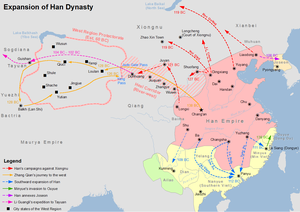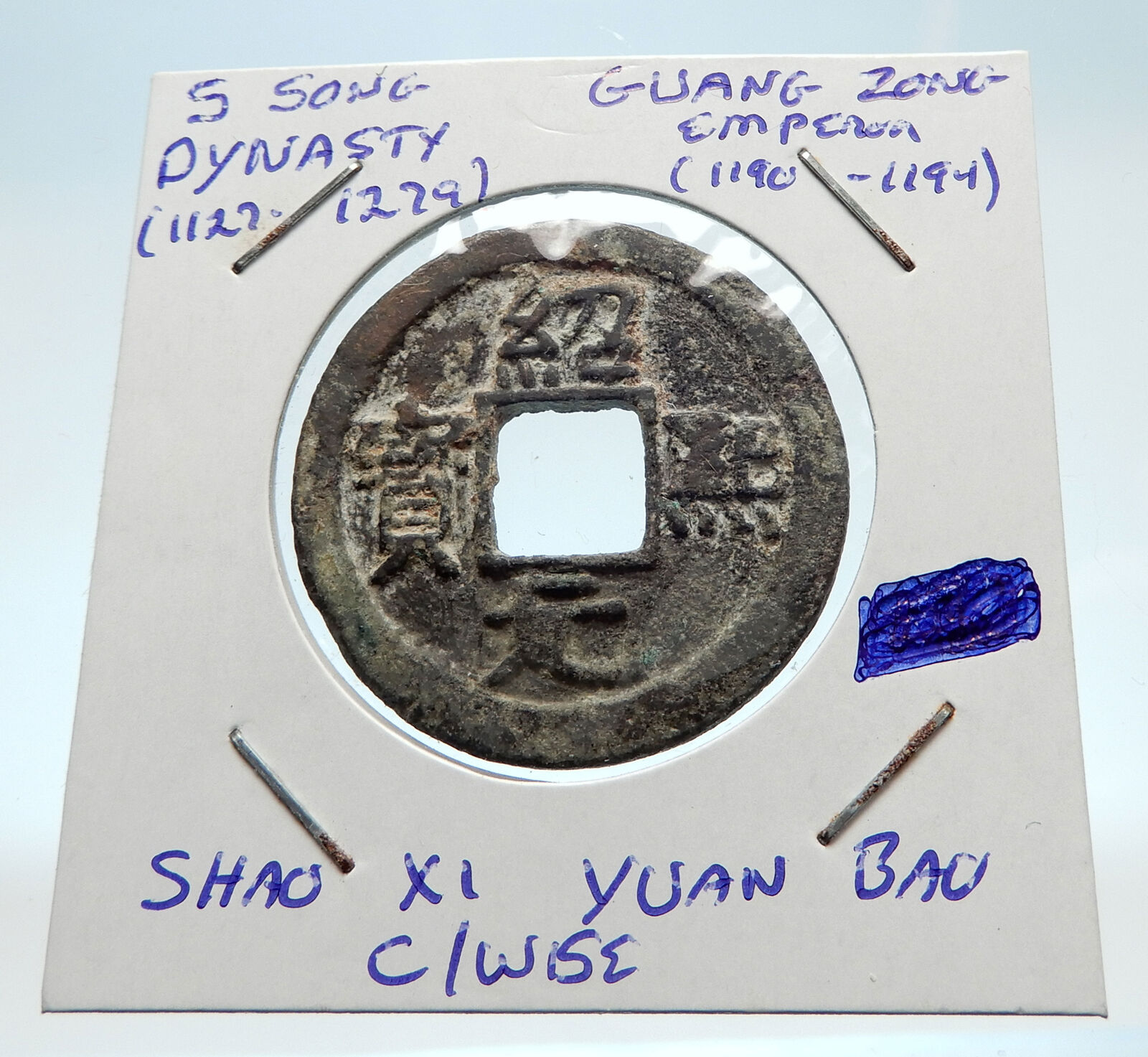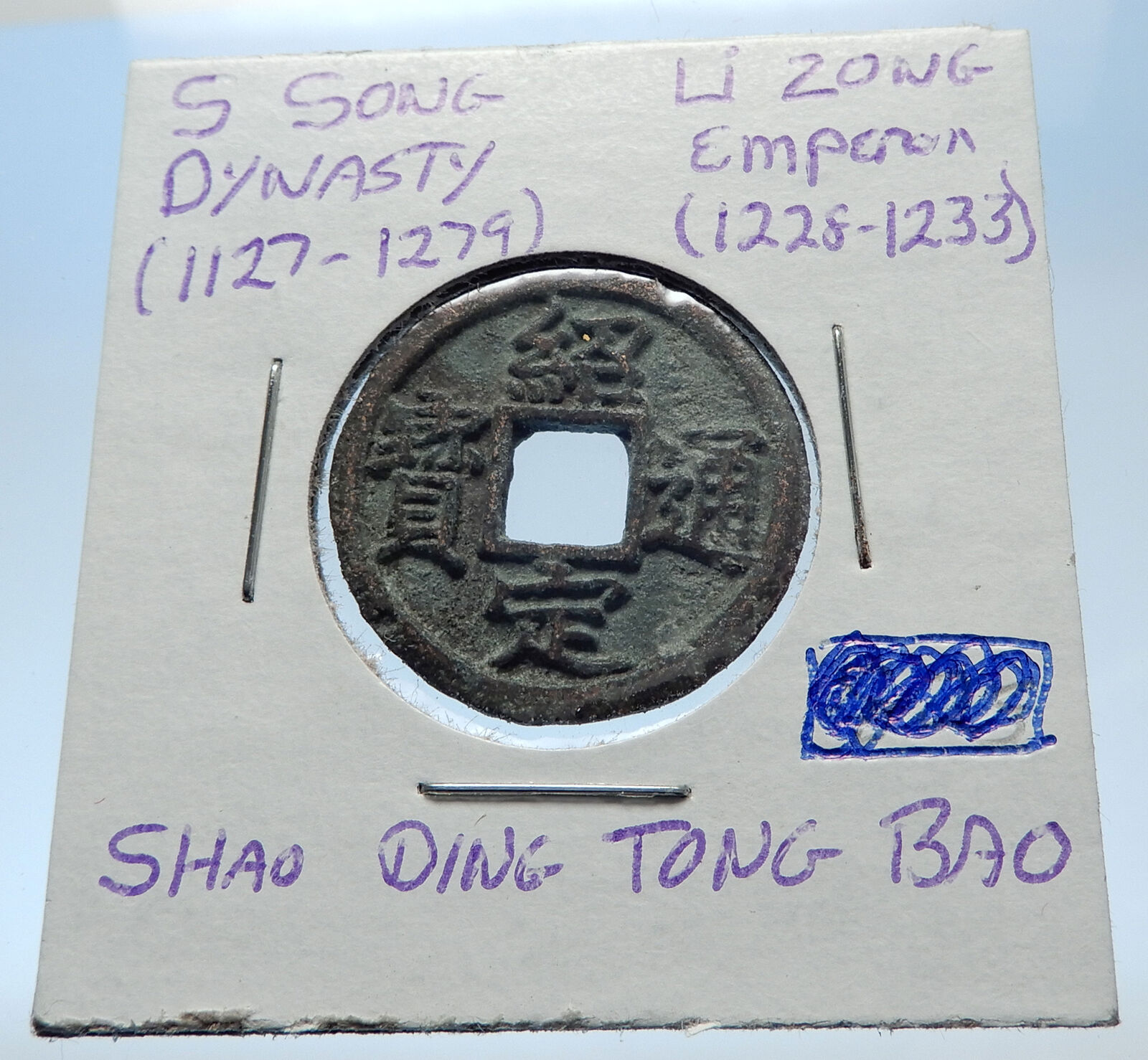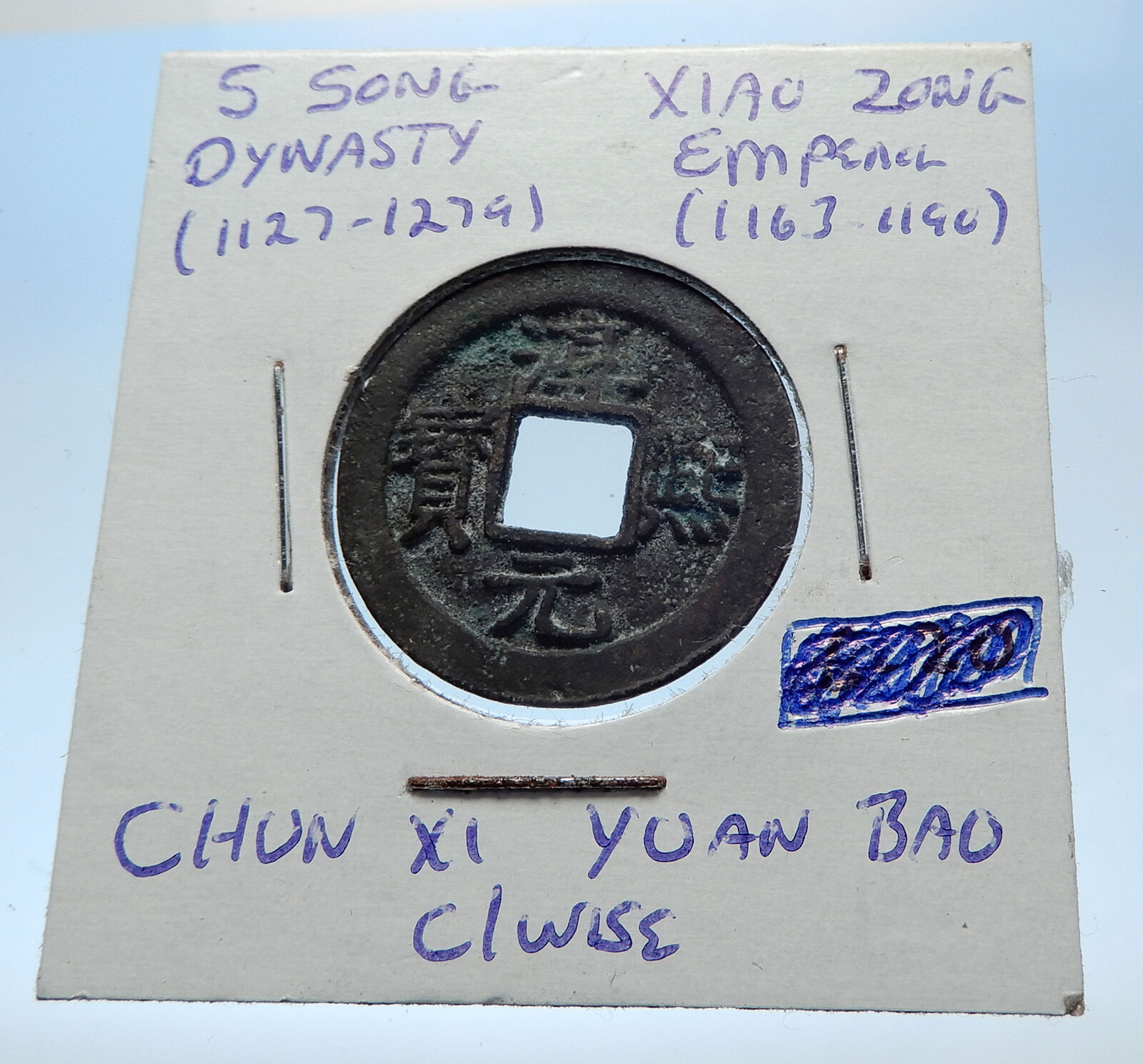|
China – Western Han Dynasty (206 BC – 9 AD)
Bronze Wu Zhu
Cash Token
25mm, Struck 206 BC – 25 AD
Reference: H# 8.9
Symbols.
No Rim above.
You are bidding on the exact item pictured, provided with a Certificate of Authenticity and Lifetime Guarantee of Authenticity.
Western Han: China’s first imperial dynasty was the Qin dynasty (221–207 BC). The Qin united the Chinese Warring States by conquest, but their regime became unstable after the death of the first emperor Qin Shi Huang. Within four years, the dynasty’s authority had collapsed in the face of rebellion. Two former rebel leaders, Xiang Yu (d. 202 BC) of Chu and Liu Bang (d. 195 BC) of Han, engaged in a war to decide who would become hegemon of China, which had fissured into 18 kingdoms, each claiming allegiance to either Xiang Yu or Liu Bang. Although Xiang Yu proved to be an effective commander, Liu Bang defeated him at the Battle of Gaixia (202 BC), in modern-day Anhui. Liu Bang assumed the title “emperor” (huangdi) at the urging of his followers and is known posthumously as Emperor Gaozu (r. 202–195 BC). Chang’an (known today as Xi’an) was chosen as the new capital of the reunified empire under Han.
 At the beginning of the Western Han (traditional Chinese: 西漢; simplified Chinese: 西汉; pinyin: Xīhàn), also known as the Former Han (traditional Chinese: 前漢; simplified Chinese: 前汉; pinyin: Qiánhàn) dynasty, thirteen centrally controlled commanderies—including the capital region—existed in the western third of the empire, while the eastern two-thirds were divided into ten semi-autonomous kingdoms. To placate his prominent commanders from the war with Chu, Emperor Gaozu enfeoffed some of them as kings. At the beginning of the Western Han (traditional Chinese: 西漢; simplified Chinese: 西汉; pinyin: Xīhàn), also known as the Former Han (traditional Chinese: 前漢; simplified Chinese: 前汉; pinyin: Qiánhàn) dynasty, thirteen centrally controlled commanderies—including the capital region—existed in the western third of the empire, while the eastern two-thirds were divided into ten semi-autonomous kingdoms. To placate his prominent commanders from the war with Chu, Emperor Gaozu enfeoffed some of them as kings.
By 196 BC, the Han court had replaced all but one of these kings (the exception being in Changsha) with royal Liu family members, since the loyalty of non-relatives to the throne was questioned. After several insurrections by Han kings—the largest being the Rebellion of the Seven States in 154 BC—the imperial court enacted a series of reforms beginning in 145 BC limiting the size and power of these kingdoms and dividing their former territories into new centrally controlled commanderies. Kings were no longer able to appoint their own staff; this duty was assumed by the imperial court. Kings became nominal heads of their fiefs and collected a portion of tax revenues as their personal incomes. The kingdoms were never entirely abolished and existed throughout the remainder of Western and Eastern Han.
To the north of China proper, the nomadic Xiongnu chieftain Modu Chanyu (r. 209–174 BC) conquered various tribes inhabiting the eastern portion of the Eurasian Steppe. By the end of his reign, he controlled Manchuria, Mongolia, and the Tarim Basin, subjugating over twenty states east of Samarkand. Emperor Gaozu was troubled about the abundant Han-manufactured iron weapons traded to the Xiongnu along the northern borders, and he established a trade embargo against the group.
In retaliation, the Xiongnu invaded what is now Shanxi province, where they defeated the Han forces at Baideng in 200 BC. After negotiations, the heqin agreement in 198 BC nominally held the leaders of the Xiongnu and the Han as equal partners in a royal marriage alliance, but the Han were forced to send large amounts of tribute items such as silk clothes, food, and wine to the Xiongnu.
Despite the tribute and a negotiation between Laoshang Chanyu (r. 174–160 BC) and Emperor Wen (r. 180–157 BC) to reopen border markets, many of the Chanyu’s Xiongnu subordinates chose not to obey the treaty and periodically raided Han territories south of the Great Wall for additional goods. In a court conference assembled by Emperor Wu (r. 141–87 BC) in 135 BC, the majority consensus of the ministers was to retain the heqin agreement. Emperor Wu accepted this, despite continuing Xiongnu raids.
However, a court conference the following year convinced the majority that a limited engagement at Mayi involving the assassination of the Chanyu would throw the Xiongnu realm into chaos and benefit the Han. When this plot failed in 133 BC, Emperor Wu launched a series of massive military invasions into Xiongnu territory. The assault culminated in 119 BC at the Battle of Mobei, where the Han commanders Huo Qubing (d. 117 BC) and Wei Qing (d. 106 BC) forced the Xiongnu court to flee north of the Gobi Desert.
After Wu’s reign, Han forces continued to prevail against the Xiongnu. The Xiongnu leader Huhanye Chanyu (r. 58–31 BC) finally submitted to Han as a tributary vassal in 51 BC. His rival claimant to the throne, Zhizhi Chanyu (r. 56–36 BC), was killed by Chen Tang and Gan Yanshou (甘延壽/甘延寿) at the Battle of Zhizhi, in modern Taraz, Kazakhstan.
 In 121 BC, Han forces expelled the Xiongnu from a vast territory spanning the Hexi Corridor to Lop Nur. They repelled a joint Xiongnu-Qiang invasion of this northwestern territory in 111 BC. In that year, the Han court established four new frontier commanderies in this region: Jiuquan, Zhangyi, Dunhuang, and Wuwei. The majority of people on the frontier were soldiers. On occasion, the court forcibly moved peasant farmers to new frontier settlements, along with government-owned slaves and convicts who performed hard labor. The court also encouraged commoners, such as farmers, merchants, landowners, and hired laborers, to voluntarily migrate to the frontier. In 121 BC, Han forces expelled the Xiongnu from a vast territory spanning the Hexi Corridor to Lop Nur. They repelled a joint Xiongnu-Qiang invasion of this northwestern territory in 111 BC. In that year, the Han court established four new frontier commanderies in this region: Jiuquan, Zhangyi, Dunhuang, and Wuwei. The majority of people on the frontier were soldiers. On occasion, the court forcibly moved peasant farmers to new frontier settlements, along with government-owned slaves and convicts who performed hard labor. The court also encouraged commoners, such as farmers, merchants, landowners, and hired laborers, to voluntarily migrate to the frontier.
 Even before Han’s expansion into Central Asia, diplomat Zhang Qian’s travels from 139 to 125 BC had established Chinese contacts with many surrounding civilizations. Zhang encountered Dayuan (Fergana), Kangju (Sogdiana), and Daxia (Bactria, formerly the Greco-Bactrian Kingdom); he also gathered information on Shendu (Indus River valley of North India) and Anxi (the Parthian Empire). All of these countries eventually received Han embassies. These connections marked the beginning of the Silk Road trade network that extended to the Roman Empire, bringing Han items like silk to Rome and Roman goods such as glasswares to China. Even before Han’s expansion into Central Asia, diplomat Zhang Qian’s travels from 139 to 125 BC had established Chinese contacts with many surrounding civilizations. Zhang encountered Dayuan (Fergana), Kangju (Sogdiana), and Daxia (Bactria, formerly the Greco-Bactrian Kingdom); he also gathered information on Shendu (Indus River valley of North India) and Anxi (the Parthian Empire). All of these countries eventually received Han embassies. These connections marked the beginning of the Silk Road trade network that extended to the Roman Empire, bringing Han items like silk to Rome and Roman goods such as glasswares to China.
From roughly 115 to 60 BC, Han forces fought the Xiongnu over control of the oasis city-states in the Tarim Basin. Han was eventually victorious and established the Protectorate of the Western Regions in 60 BC, which dealt with the region’s defense and foreign affairs. The Han also expanded southward. The naval conquest of Nanyue in 111 BC expanded the Han realm into what are now modern Guangdong, Guangxi, and northern Vietnam. Yunnan was brought into the Han realm with the conquest of the Dian Kingdom in 109 BC, followed by parts of the Korean Peninsula with the Han conquest of Gojoseon and colonial establishments of Xuantu Commandery and Lelang Commandery in 108 BC. In China’s first known nationwide census taken in 2 AD, the population was registered as having 57,671,400 individuals in 12,366,470 households.
To pay for his military campaigns and colonial expansion, Emperor Wu nationalized several private industries. He created central government monopolies administered largely by former merchants. These monopolies included salt, iron, and liquor production, as well as bronze-coin currency. The liquor monopoly lasted only from 98 to 81 BC, and the salt and iron monopolies were eventually abolished in early Eastern Han. The issuing of coinage remained a central government monopoly throughout the rest of the Han dynasty.
The government monopolies were eventually repealed when a political faction known as the Reformists gained greater influence in the court. The Reformists opposed the Modernist faction that had dominated court politics in Emperor Wu’s reign and during the subsequent regency of Huo Guang (d. 68 BC). The Modernists argued for an aggressive and expansionary foreign policy supported by revenues from heavy government intervention in the private economy. The Reformists, however, overturned these policies, favoring a cautious, non-expansionary approach to foreign policy, frugal budget reform, and lower tax-rates imposed on private entrepreneurs.
Wu Zhu (Chinese: 五銖) is a type of Chinese cash coin produced from the Han dynasty in 118 BC when they replaced the earlier San Zhu (三銖; “Three Zhu”) cash coins, which had replaced the Ban Liang (半兩) cash coins a year prior, until they themselves were replaced by the Kaiyuan Tongbao (開元通寳) cash coins of the Tang dynasty in 621 AD. The name Wu Zhu literally means “five zhu” which is a measuring unit officially weighing about 4 grams however in reality the weights and sizes of Wu Zhu cash coins varied over the years. During the Han dynasty a very large quantity of Wu Zhu coins were cast but their production continued under subsequent dynasties until the Sui.
The production of Wu Zhu cash coins was briefly suspended by Wang Mang during the Xin dynasty but after the reestablishment of the Han dynasty, the production of Wu Zhu cash coins resumed, and continued to be manufactured long after the fall of the Eastern Han dynasty for another 500 years. Minting was definitively ended in 618 with the establishment of the Tang dynasty. Wu Zhu cash coins were cast from 118 BC to 618 AD having a span of 736 years, which is the longest for any coin in the history of the world.
Cash was a type of coin of China and East Asia, used from the 4th century BC until the 20th century AD. Originally cast during the Warring States period, these coins continued to be used for the entirety of Imperial China as well as under Mongol, and Manchu rule. The last Chinese cash coins were cast in the first year of the Republic of China. Generally most cash coins were made from copper or bronze alloys, with iron, lead, and zinc coins occasionally used less often throughout Chinese history. Rare silver and gold cash coins were also produced. During most of their production, cash coins were cast but, during the late Qing dynasty, machine-struck cash coins began to be made. As the cash coins produced over Chinese history were similar, thousand year old cash coins produced during the Northern Song dynasty continued to circulate as valid currency well into the early twentieth century.
In the modern era, these coins are considered to be Chinese “good luck coins”; they are hung on strings and round the necks of children, or over the beds of sick people. They hold a place in various superstitions, as well as Traditional Chinese medicine, and Feng shui. Currencies based on the Chinese cash coins include the Japanese mon, Korean mun, Ryukyuan mon, and Vietnamese văn.
|





 At the beginning of the Western Han (traditional Chinese: 西漢; simplified Chinese: 西汉; pinyin: Xīhàn), also known as the Former Han (traditional Chinese: 前漢; simplified Chinese: 前汉; pinyin: Qiánhàn) dynasty, thirteen centrally controlled commanderies—including the capital region—existed in the western third of the empire, while the eastern two-thirds were divided into ten semi-autonomous kingdoms. To placate his prominent commanders from the war with Chu, Emperor Gaozu enfeoffed some of them as kings.
At the beginning of the Western Han (traditional Chinese: 西漢; simplified Chinese: 西汉; pinyin: Xīhàn), also known as the Former Han (traditional Chinese: 前漢; simplified Chinese: 前汉; pinyin: Qiánhàn) dynasty, thirteen centrally controlled commanderies—including the capital region—existed in the western third of the empire, while the eastern two-thirds were divided into ten semi-autonomous kingdoms. To placate his prominent commanders from the war with Chu, Emperor Gaozu enfeoffed some of them as kings. In 121 BC, Han forces expelled the Xiongnu from a vast territory spanning the Hexi Corridor to Lop Nur. They repelled a joint Xiongnu-Qiang invasion of this northwestern territory in 111 BC. In that year, the Han court established four new frontier commanderies in this region: Jiuquan, Zhangyi, Dunhuang, and Wuwei. The majority of people on the frontier were soldiers. On occasion, the court forcibly moved peasant farmers to new frontier settlements, along with government-owned slaves and convicts who performed hard labor. The court also encouraged commoners, such as farmers, merchants, landowners, and hired laborers, to voluntarily migrate to the frontier.
In 121 BC, Han forces expelled the Xiongnu from a vast territory spanning the Hexi Corridor to Lop Nur. They repelled a joint Xiongnu-Qiang invasion of this northwestern territory in 111 BC. In that year, the Han court established four new frontier commanderies in this region: Jiuquan, Zhangyi, Dunhuang, and Wuwei. The majority of people on the frontier were soldiers. On occasion, the court forcibly moved peasant farmers to new frontier settlements, along with government-owned slaves and convicts who performed hard labor. The court also encouraged commoners, such as farmers, merchants, landowners, and hired laborers, to voluntarily migrate to the frontier. Even before Han’s expansion into Central Asia, diplomat Zhang Qian’s travels from 139 to 125 BC had established Chinese contacts with many surrounding civilizations. Zhang encountered Dayuan (Fergana), Kangju (Sogdiana), and Daxia (Bactria, formerly the Greco-Bactrian Kingdom); he also gathered information on Shendu (Indus River valley of North India) and Anxi (the Parthian Empire). All of these countries eventually received Han embassies. These connections marked the beginning of the Silk Road trade network that extended to the Roman Empire, bringing Han items like silk to Rome and Roman goods such as glasswares to China.
Even before Han’s expansion into Central Asia, diplomat Zhang Qian’s travels from 139 to 125 BC had established Chinese contacts with many surrounding civilizations. Zhang encountered Dayuan (Fergana), Kangju (Sogdiana), and Daxia (Bactria, formerly the Greco-Bactrian Kingdom); he also gathered information on Shendu (Indus River valley of North India) and Anxi (the Parthian Empire). All of these countries eventually received Han embassies. These connections marked the beginning of the Silk Road trade network that extended to the Roman Empire, bringing Han items like silk to Rome and Roman goods such as glasswares to China.




